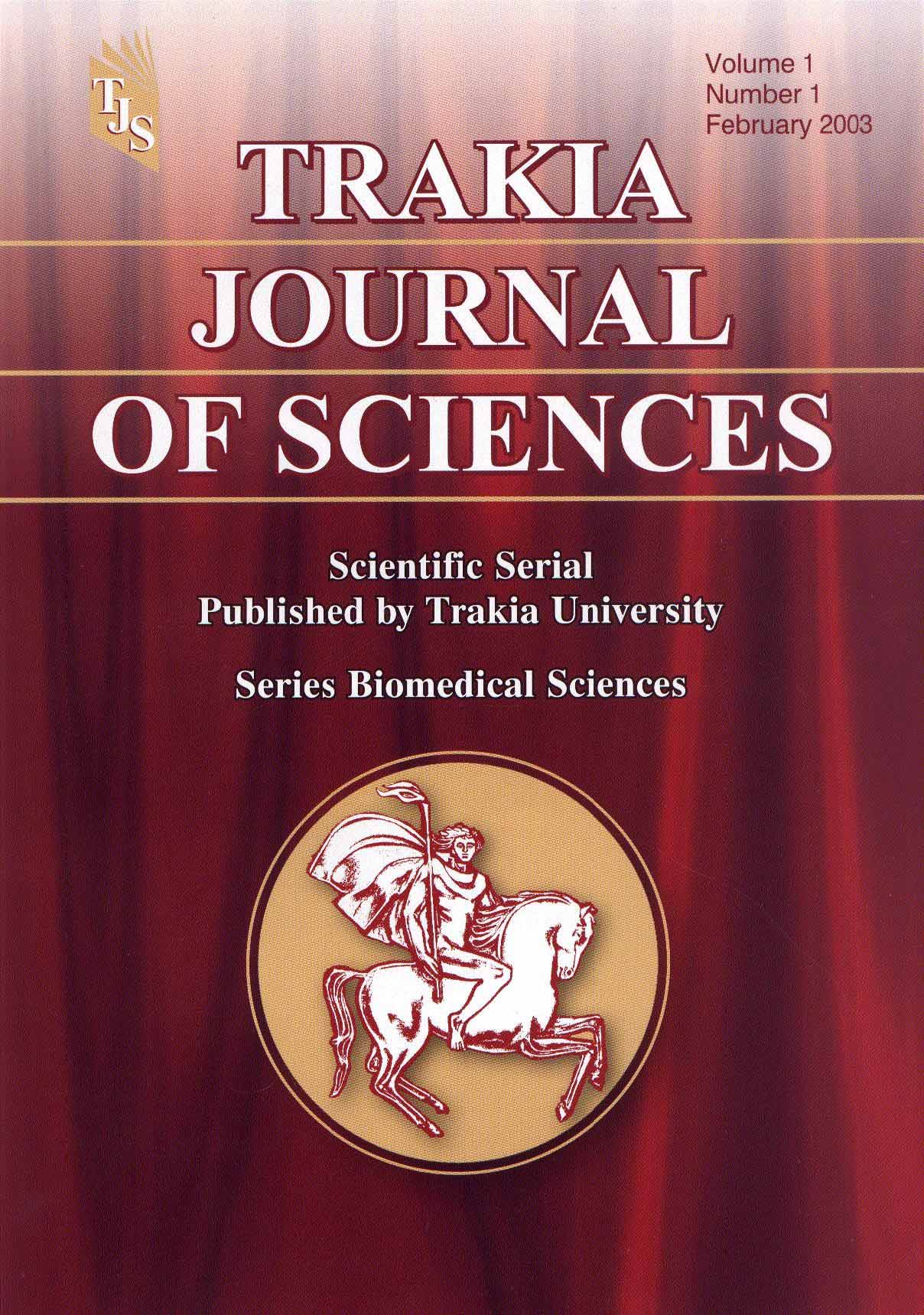DIET-INDUCED CHANGES IN SOME PARAMETERS OF OXIDATIVE SATUS IN WISTAR RATS – COMPARISON BETWEEN THREE DIFFERENT DIETS AND EFFECTS OF REPLACING DIETARY SUCROSE WITH STEVIOL GLYCOSIDES
DOI:
https://doi.org/10.15547/tjs.2024.01.003Keywords:
oxidative stress, AOPP, FRAP, catalase, glutathione, high-fat diet, high-carbohydrate dietAbstract
PURPOSE: The aim of the study was to evaluate the effects of a high-fat diet, high-carbohydrate diet and a combined high-fat high-carbohydrate diet on some parameters of oxidative status in a rat experimental model, and to test the potential positive effects of replacing sucrose with stevia extract in some of the diets. METHODS: The following parameters of oxidative status were measured: advanced oxidation protein products (AOPP), catalase, glutathione and ferric reducing ability of plasma (FRAP). Fifty-six male Wistar rats were used in the study. Rats were divided into seven groups: 1) group BD (before diet), in which parameters were measured before beginning of the diet; and six more groups in which parameters were measured after 5 weeks on the respective dietary regimen, as follows: 2) group SD (standard diet); 3) group HFD (high-fat diet); 4) group HCHD (high-carbohydrate diet); 5) group HFHCHD (high-fat high-carbohydrate diet); 6) group SD-S (standard diet with added stevia extract); 7) group HFD-S (high-fat diet with added stevia extract). RESULTS: Diets enriched with fats and carbohydrates induce significant changes in some of the oxidative status parameters. CONCLUSIONS: A five-week experimental diet enriched with fats and carbohydrates has the potential to disrupt pro-oxidant / antioxidant balance in rats.
References
Andonova, M., Nimesulide effects on the blood pro-oxidant–antioxidant status in lipopolysaccharide-challenged mice. Comparative Clinical Pathology, 28(4): 1003-1011, 2019.
Neha, K., Haider, M., Pathak, A. and Yar M., Medicinal prospects of antioxidants: A review. Eur J Med Chem, 178:687-704, 2019.
Andrés, C., Pérez de la Lastra, J., Juan, C., Plou, F. and Pérez-Lebeña, E., Polyphenols as Antioxidant/Pro-Oxidant Compounds and Donors of Reducing Species: Relationship with Human Antioxidant Metabolism. Processes, 11: 2771, 2023.
Forman, H.J. and Zhang, H., Targeting oxidative stress in disease: promise and limitations of antioxidant therapy. Nat Rev Drug Discov, 20: 689–709, 2021.
Asmat, U., Abad, K. and Ismail, K., Diabetes mellitus and oxidative stress-A concise review. Saudi Pharm J, 24(5):547-553, 2016.
Hurrle, S. and Hsu W., The etiology of oxidative stress in insulin resistance. Biomed J, 40(5):257-262, 2017.
Katerji, M., Filippova, M. and Duerksen-Hughes, P., Approaches and methods to measure oxidative stress in clinical samples: Research applications in the cancer field. Oxidative medicine and cellular longevity, 2019.
Boden, G., Obesity, insulin resistance, and free fatty acids. Curr Opin Endocrinol Diabetes Obes, 18:139–143, 2011.
Salzano, S., Checconi, P., Hanschmann, E., Lillig, C., Bowler, L. and Chan, P., Linkage of inflammation and oxidative stress via release of glutathionylated peroxiredoxin-2, which acts as a danger signal. Proc Natl Acad Sci U S A, 111:12157–12162, 2014.
Manna, P. and Jain, S. K., Obesity, Oxidative Stress, Adipose Tissue Dysfunction, and the Associated Health Risks: Causes and Therapeutic Strategies. Metab Syndr Relat Disord, 13(10):423-44, 2015.
Wong, S. K., Chin, K. Y., Suhaimi, F. H., Fairus, A. and Ima-Nirwana, S., Animal models of metabolic syndrome: a review. Nutr Metab (Lond), 4;13:65, 2016.
Andonova, M., Dzhelebov, P., Trifonova, K., Yonkova, P., Kostadinov, N., Nancheva, K., Ivanov, V., Gospodinova, K., Nizamov, N., Tsachev, I. and Chernev, C., Metabolic Markers Associated with Progression of Type 2 Diabetes Induced by High-Fat Diet and Single Low Dose Streptozotocin in Rats. Veterinary Sciences, 10(7): 431, 2023.
Buettner, R., Scholmerich, J. and Bollheimer, L. C., High-fat diets: modeling the metabolic disorders of human obesity in rodents. Obesity (Silver Spring), 15:798–808, 2007.
Halade, G., Rahman, M., Williams, P. and Fernandes, G., High fat diet-induced animal model of age-associated obesity and osteoporosis. J Nutr Biochem., 21:1162–9, 2010.
Rodríguez-Correa, E., González-Pérez, I., Clavel-Pérez, P., Contreras-Vargas, Y. and Carvajal, K., Biochemical and nutritional overview of diet-induced metabolic syndrome models in rats: what is the best choice? Nutr Diabetes, 10(1):24, 2020.
Zivkovic, A., German, J. and Sanyal, A., Comparative review of diets for the metabolic syndrome: implications for nonalcoholic fatty liver disease. Am J Clin Nutr, 86:285–300, 2007.
Adedeji, T., Jeje, S., Omayone, T. and Agbonifo W., Oxidative stress and inflammatory response to high dietary fat and carbonated soda intake in male and female Wistar rats. Nutrition, 103-104:111800, 2022.
Gerardi, G., Cavia-Saiz, M., Rivero-Pérez, M. D., González-SanJosé, M. L. and Muñiz, P., Wine pomace product modulates oxidative stress and microbiota in obesity high-fat diet-fed rats. Journal of Functional Foods, 68, 103903, 2020.
Papaefthimiou, M., Kontou, P., Bagos, P. and Braliou, G., Antioxidant Activity of Leaf Extracts from Stevia rebaudiana Bertoni Exerts Attenuating Effect on Diseased Experimental Rats: A Systematic Review and Meta-Analysis. Nutrients, 15(15):3325, 2023.
Kurek, J., Król, E. and Krejpcio, Z., Steviol Glycosides Supplementation Affects Lipid Metabolism in High-Fat Fed STZ-Induced Diabetic Rats. Nutrients, 13(1):112, 2020.
Hanasand, M., Omdal, R., Norheim, K. B., Gøransson, L. G., Brede, C., and Jonsson, G., Improved detection of advanced oxidation protein products in plasma. Clinica chimica acta, 413(9-10): 901-906, 2012.
Góth, L., A simple method for determination of serum catalase activity and revision of reference range. Clin Chim Acta. 196(2-3):143-51, 1991.
Beutler, E., Duron, O. and Kelly, B. M., Improved method for the determination of blood glutathione. The Journal of laboratory and clinical medicine, 61: 882-888, 1963.
Benzie, F. and Strain, J., The ferric reducing ability of plasma (FRAP) as a measure of antioxidant power: the FRAP assay. Analytical Biochem, 239: 70-76, 1996.
Jiang, S., Liu, H. and Li, C., Dietary Regulation of Oxidative Stress in Chronic Metabolic Diseases. Foods, 10(8):1854, 2021.
Checa, J. and Aran, J., Reactive Oxygen Species: Drivers of Physiological and Pathological Processes. J Inflamm Res, 13:1057-1073, 2020.
Del Río, L. and López-Huertas, E., ROS generation in peroxisomes and its role in cell signaling. Plant Cell Physiol, 57:1364–1376, 2016.
Turrens, J.F., Mitochondrial formation of reactive oxygen species. The Journal of Physiology, 552 (2): 335–344, 2003.
Berlett, B. and Stadtman E., Protein oxidation in aging, disease, and oxidative stress. Journal of Biological Chemistry, 272(33):20313–20316, 1997.
Piwowar, A., Zaawansowane produkty utleniania białek. Cześć I. Mechanizm powstawania, struktura i właściwości [Advanced oxidation protein products. Part I. Mechanism of the formation, characteristics and property]. Pol Merkur Lekarski, 28(164):166-9, 2010.
Lasker, S., Rahman, M., Parvez, F., Zamila, M., Miah, P., Nahar, K., Kabir, F., Sharmin, S., Subhan, N., Ahsan, G. and Alam, M., High-fat diet-induced metabolic syndrome and oxidative stress in obese rats are ameliorated by yogurt supplementation. Sci Rep., 9(1):20026, 2019.
Muñoz, A. and Costa, M., Nutritionally mediated oxidative stress and inflammation. Oxidative medicine and cellular longevity, 2013.
Chelikani, P., Fita, I. and Loewen, P., Diversity of structures and properties among catalases. Cellular and Molecular Life Sciences. 61 (2): 192–208, 2004.
Rindler, P. M., Plafker, S. M., Szweda, L. I. and Kinter, M., High dietary fat selectively increases catalase expression within cardiac mitochondria. Journal of Biological Chemistry, 288(3): 1979-1990, 2013.
Jarukamjorn, K., Jearapong, N., Pimson, C. and Chatuphonprasert, W., A high-fat, high-fructose diet induces antioxidant imbalance and increases the risk and progression of nonalcoholic fatty liver disease in mice. Scientifica, 2016.
Rubio, C. P., Martinez-Subiela, S., Hernández-Ruiz, J., Tvarijonaviciute, A. and Ceron, J. J., Analytical validation of an automated assay for ferric-reducing ability of plasma in dog serum. Journal of Veterinary Diagnostic Investigation, 29(4): 574-578, 2017.
Piątek-Guziewicz, A., Zagrodzki, P., Paśko, P., Krośniak, M., Mach, T. and Zwolińska-Wcisło, M., Ferric reducing ability of plasma and assessment of selected plasma antioxidants in adults with celiac disease. Folia Med Cracov, 57(4):13-26, 2017.

Downloads
Published
Issue
Section
License
Copyright (c) 2024 Trakia University

This work is licensed under a Creative Commons Attribution-NonCommercial 4.0 International License.


